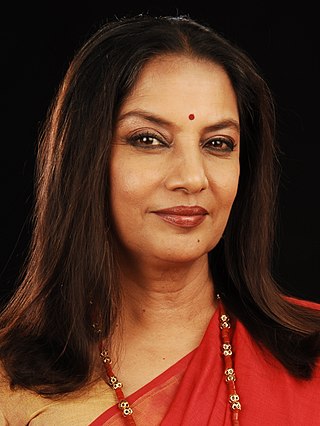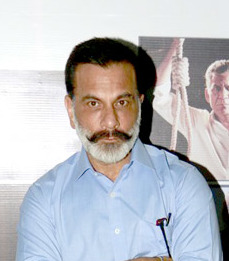The National Film Award for Best Feature Film is one of the categories in the National Film Awards presented annually by the National Film Development Corporation of India, the organisation set up by Ministry of Information and Broadcasting in India. It is one of several awards presented for feature films and awarded with the Golden Lotus. The award is announced for films produced in a year across the country, in all Indian languages. As of 2024, the award comprises a Swarna Kamal, a certificate, and a cash prize of ₹3,00,000 and is presented to the producer and the director of the film.
The NationalFilm Award for Best Tamil Feature Film is one of the National Film Awards presented annually by the National Film Development Corporation of India. It is one of several awards presented for feature films and awarded with Rajat Kamal.
The National Film Award for Best Direction is an honour presented annually at India's National Film Awards ceremony by the National Film Development Corporation of India (NFDC), an organisation set up by the Indian Ministry of Information and Broadcasting. Since 1967, the award is given by a national panel appointed annually by the NFDC to a director for their work within Indian cinema. It is presented by the president of India at a ceremony held in New Delhi.

The National Film Award for Best Actor in a Leading Role is an honour presented annually at the National Film Awards of India instituted since 1967 to actors who have delivered the best performance in a leading role within the Indian film industry. Called the "State Awards for Films" when established in 1954, the National Film Awards ceremony is older than the Directorate of Film Festivals. The State Awards instituted the individual award in 1968 as the "Bharat Award for the Best Actor"; in 1975, it was renamed as the "Rajat Kamal Award for the Best Actor". Throughout the past 45 years, accounting for ties and repeat winners, the Government of India has presented a total of 52 "Best Actor" awards to 40 actors. Until 1974, winners of the National Film Award received a figurine and certificate; since 1975, they have been awarded with a "Rajat Kamal", certificate and a cash prize. Since the 70th National Film Awards, the name was changed to "National Film Award for Best Actor in a Leading Role".

The National Film Award for Best Actress in a Leading Role is an honour presented annually at the National Film Awards of India since 1968 to an actress for the best performance in a leading role within the Indian film industry. The National Film Awards were called the "State Awards for Films" when established in 1954. The State Awards instituted the "Best Actress" category in 1968 as the "Urvashi Award for the Best Actress"; in 1975, the Urvashi Award was renamed as the "Rajat Kamal Award for the Best Actress". Throughout the years, accounting for ties and repeat winners, the Government of India has presented a total of 56 Best Actress awards to 45 different actresses. Since the 70th National Film Awards, the name was changed to "National Film Award for Best Actress in a Leading Role".

The National Film Award for Best Actor in a Supporting Role is an honour presented annually at India's National Film Awards ceremony by the National Film Development Corporation of India (NFDC), an organisation set up by the Indian Ministry of Information and Broadcasting. A national panel appointed annually by the NFDC selects the actor who has given the best performance in a supporting role within Indian cinema. The award is presented by the President of India at a ceremony held in New Delhi. Since the 70th National Film Awards, the name was changed to "Best Actor in a Supporting Role".

The National Film Award for Best Actress in a Supporting Role is an honour presented annually at India's National Film Awards ceremony by the National Film Development Corporation of India (NFDC), an organisation set up by the Indian Ministry of Information and Broadcasting. Since 1984, the award is given by a national panel appointed annually by the NFDC to an actress for the best performance in a supporting role within Indian cinema. It is presented by the President of India at a ceremony held in New Delhi. Since the 70th National Film Awards, the name was changed to "Best Actress in a Supporting Role".

The National Film Award for Best Music Direction is an honour presented annually at the National Film Awards by the National Film Development Corporation of India to a musician who has composed the best score for films produced within the Indian film industry. The award was first introduced at the 15th National Film Awards in 1967. At the 42nd National Film Awards, an award for "Best Background Score" was instituted. It was however discontinued after that, and it was not until 2009 that the category was re-introduced. Later, during the 70th National Film Awards both the categories — Best Background Score and Best Background Music were clubbed together and named as "Best Background Music". A total of 51 awards—including award for Best Background music—to 40 different composers.
The National Film Award for Best Editing is one of the National Film Awards presented annually by the National Film Development Corporation of India. It is one of several awards presented for feature films and awarded with Rajat Kamal.
The National Film Award for Best Bengali Feature Film is one of the National Film Awards presented annually by the National Film Development Corporation of India. It is one of several awards presented for feature films and awarded with Rajat Kamal. Since the 70th National Film Awards, the name was changed to "Best Bengali Feature Film".
The National Film Award for Best Assamese Feature Film is one of the National Film Awards presented annually by the National Film Development Corporation of India. It is one of several awards presented for feature films and awarded with Rajat Kamal.
The National Film Award for Best Malayalam Feature Film is one of the National Film Awards presented annually by the National Film Development Corporation of India. It is one of several awards presented for feature films and awarded with Rajat Kamal. Since the 70th National Film Awards, the name was changed to "Best Malayalam Feature Film".
The National Film Award for Best Telugu Feature Film is one of the National Film Awards presented annually by the National Film Development Corporation of India. It is one of several awards presented for feature films and awarded with Rajat Kamal.

The National Film Award for Best Male Playback Singer is an honour presented annually at the National Film Awards of India since 1968 to a male playback singer for the best renditions of songs from films within the Indian film industry. The award was first granted to Mahendra Kapoor in 1967. The singers whose performances have won awards have worked in nine major languages: Hindi, Malayalam, Bengali, Telugu and Marathi, Tamil, Kannada, and Punjabi.
The Nargis Dutt Award for Best Feature Film on National Integration was one of the National Film Awards presented annually by the Directorate of Film Festivals, the organization set up by Ministry of Information and Broadcasting, India. It is one of several awards presented for feature films and awarded with Rajat Kamal. At the 70th National Film Awards, the category was discontinued and combined with Best Film on Environment Conservation/Preservation, Best Film on Family Welfare and Best Film on Other Social Issues. The new award is named as Best Feature Film Promoting National, Social and Environmental Values.
The National Film Award for Best Kannada Feature Film is one of the National Film Awards presented annually by the National Film Development Corporation of India. It is one of several awards presented for feature films and awarded with Rajat Kamal. Since the 70th National Film Awards, the name was changed to "Best Kannada Feature Film".
The National Film Award for Best Film on Family Welfare was one of the National Film Awards presented annually by the Directorate of Film Festivals, the organisation set up by Ministry of Information and Broadcasting, India. It was one of several awards presented for feature films and awarded with Rajat Kamal. At the 70th National Film Awards, the category was discontinued and combined with Best Film on Environment Conservation/Preservation, Best Film on National Integration and Best Film on Other Social Issues. The new award is named as Best Feature Film Promoting National, Social and Environmental Values.
The National Film Award for Best Educational/Motivational/Instructional Film was one of the National Film Awards presented annually by the Directorate of Film Festivals, the organisation set up by Ministry of Information and Broadcasting, India. It was one of several awards presented for non-feature films and awarded with Rajat Kamal.
The National Film Award for Second Best Feature Film was one of the National Film Awards presented annually by the Directorate of Film Festivals, the organisation set up by Ministry of Information and Broadcasting, India. It was one of several awards presented for feature films and awarded with Rajat Kamal.
The National Film Award for Best Odia Feature Film is one of the National Film Awards presented annually by the National Film Development Corporation of India. It is one of several awards presented for feature films and awarded with Rajat Kamal.





